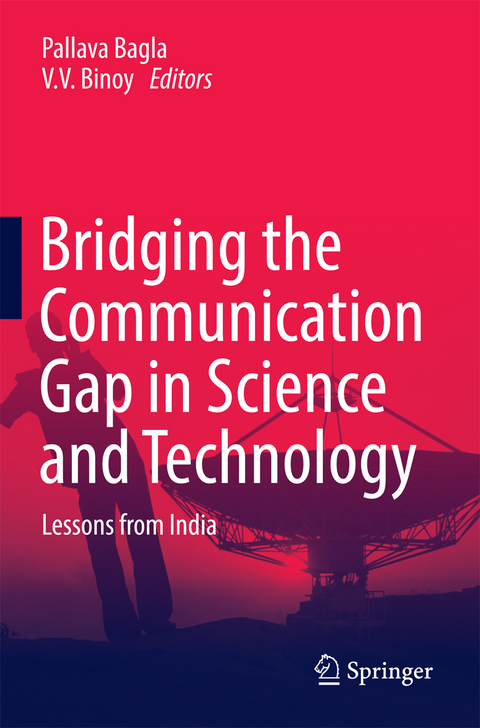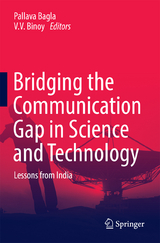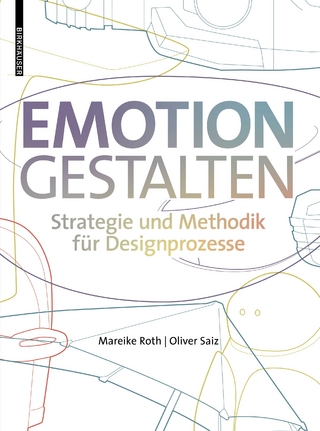Bridging the Communication Gap in Science and Technology
Springer Verlag, Singapore
978-981-10-1024-8 (ISBN)
straditional ways of outreach like people’s science movements, holding popular science events, and fairs, the volume provides highly valuable directions on how developing countries with low resources and complex populations can communicate S&T research to the public and bridge communication gaps.
This volume will interest researchers from science, social science, mass communication and public relations departments, journalists, as well as practitioners and policy makers from government and non-government institutions involved in S&T policy, practice and communication and people who want to understand the complex S&T landscape of India.
Pallava Bagla is an Indian science journalist, communicator & photojournalist with over 25 years of experience. In 2014 he was the Shri T.V. Raman Pai Chair Visiting Professor of Science Communication, at the National Institute of Advanced Studies, Bangalore. He has been the Science Editor of India’s highly respected private television channel New Delhi Television (NDTV) since 2006. In his almost two decades of continuous writing for Science magazine, he has critically analysed India’s prowess in S&T. He also runs a weekly column on science, technology, health and environment for India’s trusted news agency, the Press Trust of India (PTI). Bagla's recent work includes giving an insider’s look into India’s little known but highly developed missile development programme. He is the author of several books, some of the most recent being Reaching for the Stars: India’s Journey to Mars and Beyond (Bloomsbury, 2014), Destination Moon: India’s Quest for Moon, Mars and Beyond (HarperCollins, 2008). He is the winner of many awards for his work, and most recently in 2014, he was feted by the Prime Minister of India with an award for `excellence in journalism’. V.V. Binoy is Assistant Professor, School of Natural Sciences and Engineering, National Institute of Advanced Studies, Bangalore, India. Dr. Binoy explores the biological and environmental basis of decision-making and personality traits (also referred to as individual variation in the behaviour or behavioural syndrome) in vertebrates using fish and amphibian model systems. He is interested in the popularization of science using non-conventional methodologies of communication and also studies the efficacy of ‘citizen science’ in data collection and dissemination of information to the grass-roots levels of society. Binoy has been a recipient of the ‘Cognitive Science Research Initiative Postdoctoral Fellowship’ and ‘Young Scientist’ start-up research grant from the Department of Science and Technology, Government of India.
Chapter 1. Introduction V.V. Binoy and Pallava Bagla.- Part I: Communicating Science to Win the Hearts and Minds.- Chapter 2. Responsibilities of Science, Responsive to Society: A New Dialogue Jairam Ramesh.- Part II: The Indian Landscape of Communicating Science and Technology.- Chapter 3. India’s Maiden Mission to Mars: Many Firsts and Some Missed Opportunities in Isro’s Efforts at Public Outreach and Communications Pallava Bagla.- Chapter 4. Challenges in Communicating about Defence Research: Insights in Defence Research and Development Organization’s (Drdo) Media Strategy Ravi Kumar Gupta.- Chapter 5. Communicating Issues related to Land and Natural Resources. S. Meenakshisundaram.- Chapter 6. The Art and Science of Communicating Risks of Natural Hazards Ajit Tyagi.- Chapter 7. The Challenges of Earthquake Risk Communicatio
n to Public R. K. Chadha.- Chapter 8.The Queer Case of Communicating Risks Associated With Use of Mobile Phones and Neighbourhood Mobile Towers: Are People Contracting More Brain Cancers K.S. Parthasarathy.- Chapter 9. Atomic Energy: Reaching Out the People for Perception Management S.K. Malhotra.- Part III: Time-Tested ways of Communication.- Chapter 10. Communicating Science for a Better Tomorrow Hasan Jawaid Khan.- Chapter 11. Current Status of Public Understanding of Science: Results of Kumbh Mela Survey Studies Gauhar Raza and Surjit Singh.- Chapter 12. Challenges of Communicating Science in Regional Languages: Experiments in Kannada A.S.K.V.S. Sharma.- Chapter 13. Challenges Faced by Science Journalists and Communicators Working in Vernacular Languages and Insights Pertaining to Science Communication Courses Nimish Kapoor.- Part IV: Using Television, the Internet and Social Media for Messages.- Chapter 14. Enhancing Science Content on Indian Tv: Status, Issues and Way Forward T.V. Venkateswaran.- Chapter 15. Scidev.net T.V. Padma.- Chapter 16. Smart Websites: Insights from DBT Archita Bhatta.- Chapter 17. Using Social Media for Research and Reaching Out Sandhya Sekar and Sudhira H. S..- Part V: Bridging the Gap Between Scientists and the Public.- Chapter 18. Vigyan Rail: Science Exhibition on Wheels Vinay B. Kamble.- Chapter 19. Organising Children’s Science Congress: Challenges and Opportunities E.R. Anuj Sinha.- Chapter 20. Bridging Educational Institutions For a Citizen Science Project: A Case Study From Malappuram District, Kerala, India V.V. Binoy, S. Radhakrishna and A. Kurup.- Chapter 21. Community Driven Approach for Artificial Recharge: The TBS Experience Rajendra Singh.
| Erscheinungsdatum | 27.11.2016 |
|---|---|
| Zusatzinfo | 47 Illustrations, color; XXVI, 324 p. 47 illus. in color. |
| Verlagsort | Singapore |
| Sprache | englisch |
| Maße | 155 x 235 mm |
| Themenwelt | Sachbuch/Ratgeber ► Natur / Technik |
| Naturwissenschaften | |
| Sozialwissenschaften ► Kommunikation / Medien ► Kommunikationswissenschaft | |
| Sozialwissenschaften ► Kommunikation / Medien ► Medienwissenschaft | |
| Sozialwissenschaften ► Pädagogik | |
| Technik ► Elektrotechnik / Energietechnik | |
| ISBN-10 | 981-10-1024-2 / 9811010242 |
| ISBN-13 | 978-981-10-1024-8 / 9789811010248 |
| Zustand | Neuware |
| Haben Sie eine Frage zum Produkt? |
aus dem Bereich




